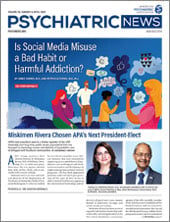APA’s new practice guideline on borderline personality disorder is hoped to help clinicians improve their ability to identify this condition in the face of common differential diagnoses such as bipolar disorder. Available now as a
preprint, the final document and supporting materials will be available this fall.
The confusion between borderline personality disorder and bipolar disorder arises since both conditions share some hallmark symptoms like mood instability and impulsivity. However, the underlying reasons why these symptoms manifest are quite different, as are the treatment recommendations; treating a patient with borderline personality disorder for bipolar disorder, or vice versa, can lead to serious health risks. To reduce misdiagnosis, two experts advise psychiatrists and other physicians to look beyond the mood features of the disorders.
“The DSM lists mood instability as a criterion for borderline personality disorder, but it’s just one of nine and not the most important,” Nassir Ghaemi, M.D., M.P.H., a professor of psychiatry and pharmacology at Tufts University School of Medicine, told Psychiatric News.
Differentiating between borderline personality disorder and bipolar disorder has long been a challenge for many physicians, explained Marsal Sanches, M.D., Ph.D., a professor of psychiatry and behavioral sciences at Baylor College of Medicine. Even after the addition of borderline personality disorder to DSM-III in 1980, some psychiatrists questioned whether it was a valid diagnostic construct.
The argument made by these psychiatrists, as described by Marsal Sanches in a 2019
review article in the journal
Diseases, was that borderline personality disorder was a bipolar illness characterized by ultrarapid mood cycles.
“I am against the concept of this spectrum where everyone who has mood swings has some type of bipolar disorder,” said Joel Paris, M.D., an emeritus professor of psychiatry at McGill University in Montreal as well as a psychiatrist and researcher at Jewish General Hospital. “The mood swings occurring in bipolar disorder and borderline personality disorder are completely different phenomena.”
The emotional highs of borderline personality disorder, for example, are highly sensitive to the environment. “If someone with borderline in an elevated state feels invalidated or rejected, they can crash straight into a depression. It’s more mood instability than mood swings.” Bipolar mania, meanwhile, is episodic and is more resistant to such psychosocial trigger factors.
One clinical distinction that is often cited is that the mania-like symptoms of borderline personality disorder are transient; they typically last a couple of days or sometimes end within hours. In contrast, the DSM-5 criteria state that an episode of bipolar mania must be present for at least seven days, while bipolar hypomania must be present for at least four.
Ghaemi, however, suggested not placing too much emphasis on episode duration. He told
Psychiatric News that research going back to the 1970s suggests that hypomania episodes can be present for as few as
two days or even less.
“Instead of mood, focus on the many areas where these disorders differ,” Ghaemi advised. For example, cutting and/or other self-harm behaviors are present in about two-thirds of individuals with borderline personality disorder, but only about 5% of those with bipolar. Sexual abuse is also three times more frequent in people with borderline personality disorder.
Bipolar disorder, meanwhile, has a much stronger hereditary component than borderline personality disorder, Ghaemi continued; one of the best ways to confirm a bipolar diagnosis in a patient is to find out whether there is any family history of the disorder. That is why obtaining a thorough patient and family history is important for differentiating these conditions.
A big obstacle in accurate diagnosis is that physicians have personal biases and limited time, Paris said. Many doctors—consciously or subconsciously—diagnose a patient with bipolar diagnosis rather than borderline personality disorder because that lets them prescribe a treatment.
It’s a harmful assumption, Paris noted. “In the short term, antipsychotics may help reduce borderline mood swings a little bit, but otherwise the medications you might prescribe for someone with bipolar disorder are useless for borderline personality disorder,” he said.
Paris, who has been working with patients with borderline personality disorder for decades, acknowledged there are always instances in which patients’ symptom history presents a challenge, but that by and large a clinician can differentiate these disorders by taking a little time and asking the right questions. ■

